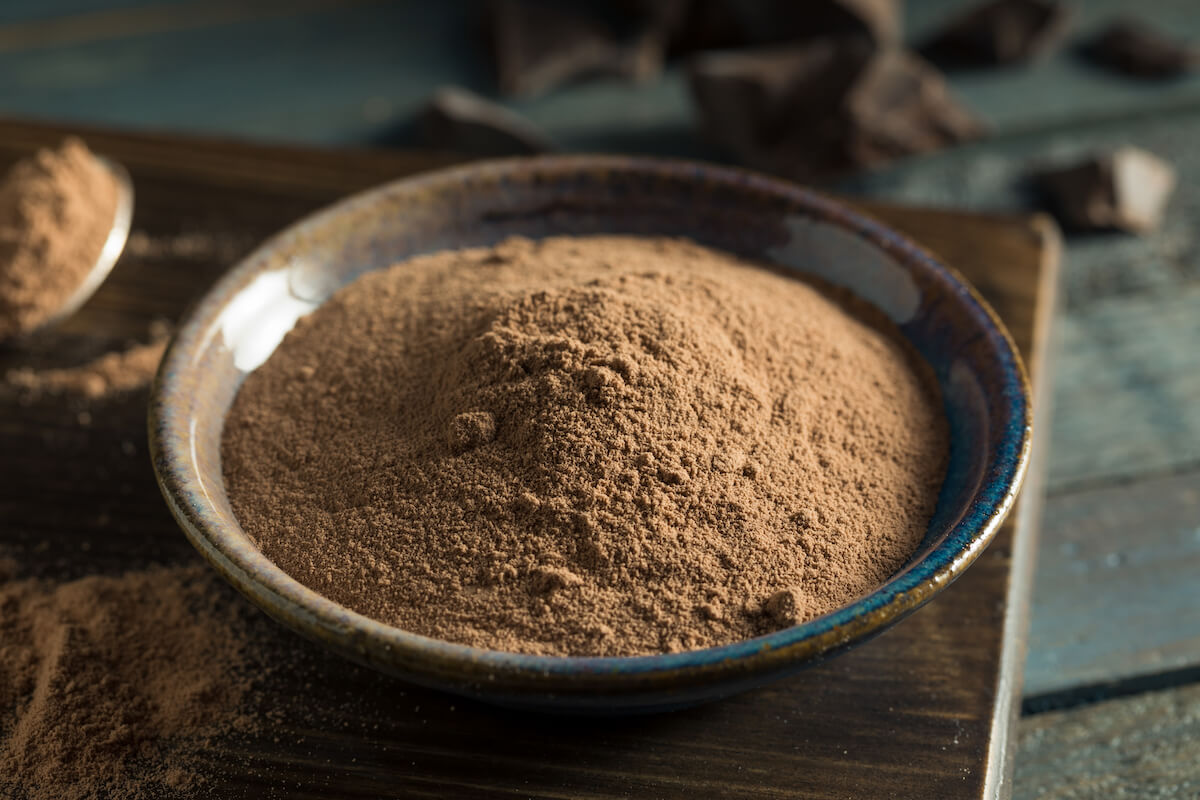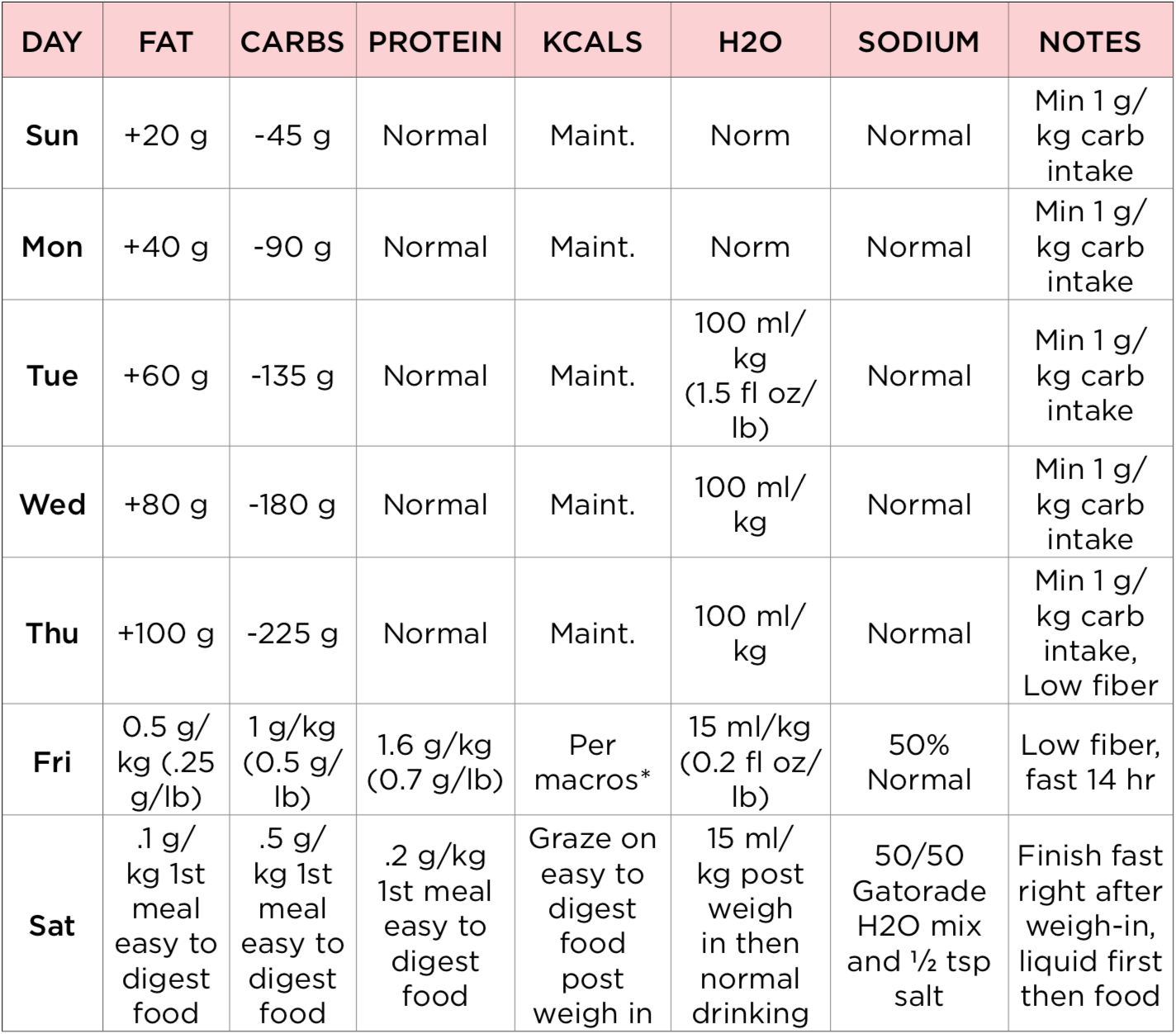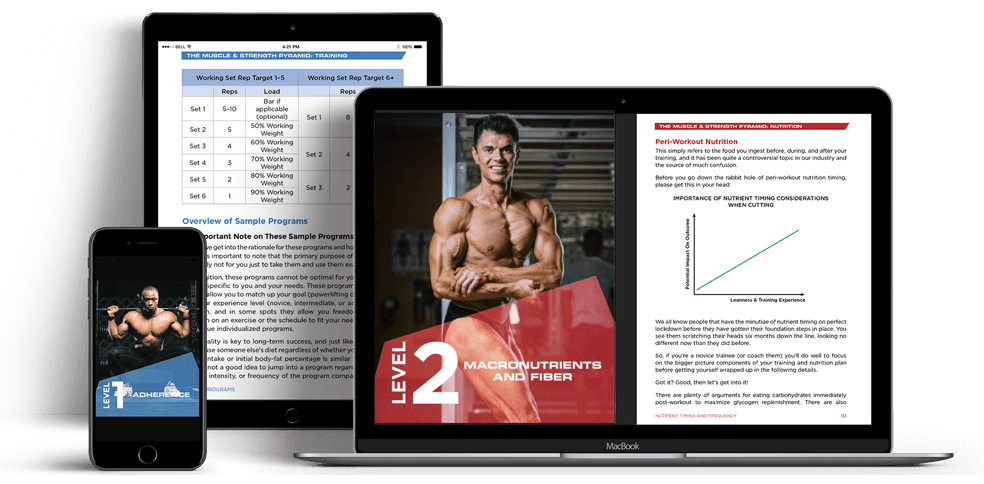If you’re a fan of boxing or MMA, you may have wondered how professional fighters can walk around in the ring some 15–20 lbs heavier than they weighed in the day before.
The answer, for the most part, involves an extreme level of water manipulation. Professional fighters with a 24-hour weigh-in have no choice but to dehydrate and then rush to rehydrate in the 24 hours before the fight if they wish to be competitive. — The more weight they can successfully cut; the lighter the weight category they can compete in and the greater the size advantage.
If pushed too far they will fail to recover and lose the fight.
Fortunately, weightlifters, powerlifters, and amateur fighters are saved from this brutal practice as the weigh-in is typically just 2 hours prior to competing. Still, there is a solid opportunity to manipulate your weight in the last week.
If you can carry 5-10 lbs more muscle than your weight class cut off, but temporarily manipulate your weight to ‘make the cut’ that’s a significant advantage you can have over your competition.
The methods in this guide will show you how to reliably drop 3–5% of your body weight over a week without being in a caloric deficit. We’ve ranked them from their lowest to highest performance risk, and I imagine you’ll be delighted to know that we’ll be suggesting you consider switching to candy and chocolate as part of this.
We hope you enjoy this excerpt from The Muscle and Strength Nutrition Pyramid…
6 Steps to Cut Weight for a Powerlifting (or Weightlifting) Competition
An Important Caveat Before We Begin
What isn’t in this article, but which is in the full book, is how I wholeheartedly recommend against novices, juniors, especially teens, and even intermediate level lifters from repeatedly doing fat loss phases to make weight.
Advanced lifters looking to qualify, break records, win international or national competitions, sure. Other lifters who are sitting 1-2% over without dieting who can do something mild in the preceding day prior to comp, also fine. But spending time dieting when you haven’t even built most of your strength capacity (that is unless you are dieting for health or personal reasons unrelated to sport), is you getting in the way of your long term potential to serve a short term goal.
Now let’s begin…
Everything in the book leading up to this section was dedicated to teaching you how to manage your nutrition for your strength sport. Thus, if you fit the bill as someone who could consider dropping a weight class, you already know the long-term process of how to achieve that.
However, this doesn’t necessarily mean you need to diet all the way down to your weight class via fat loss. Indeed, if you are up to 5% over your target weight class, one week out from the competition, you can utilize short-term weight reduction strategies to drop the last bit of scale weight via losses of body water and the weight of gut contents.
Before we get into these strategies, let me first say that as a coach who works with drug-free lifters, 99% of my experience is with the IPF and its affiliates. Thus, the following primarily applies to 2-hour weigh ins (after making weight you only have two hours until competition). This is why I don’t advise cutting any more than 5% of your bodyweight in the short term (and I prefer less).
While more can be lost from acute methods, it is very difficult to put that much (water) weight back on in two hours. Making weight isn’t the issue, it’s getting back up to a weight conducive to performing that is the problem.
So for those who aren’t quite following me, to be clear, in this final week before you hit the platform we are no longer thinking about fat loss. In the final week, the only concern is what your actual weight is when you weigh in, and how to manipulate that in the short term.
Thus, the variables of interest at this stage are the actual weight of food relative to their energy content, body water, the weight of the contents of the gut, and ensuring a minimal impact on performance after making weight.
Reducing Gut Content
The safest way to lose weight that won’t impact your performance is to simply consume a low fiber, high energy-density diet.
While fiber is great for long-term gut health and it is one of the reasons why fruits, vegetables, and whole grains are considered part of a balanced diet, they also slow the digestive process and leave more fecal matter in your colon.
Spending 2–4 days on a <10 g/day fiber diet can reduce the weight of the contents of your digestive tract.
In addition to a lower fiber count, eating foods that are energy dense and low in weight to reach your caloric and macronutrient targets is a good idea. Instead of having multiple servings of fruit, vegetables, whole grains and lean meats like you might during a fat loss phase, a couple of scoops of whey, some candy, and chocolate would allow you to hit your energy and macro targets while keeping the weight of food much lower.
Between eating a diet that simply weighs less and reducing your gut content via a low fiber intake, you can achieve a lowered bodyweight without dieting or dehydrating yourself at all (often good for approximately a ~1–2% reduction in bodyweight depending on the individual) 1.

Reducing Body Water
Aerobic and skill-based performances are hindered by even a 2% loss in body water, but strength and power seem to be slightly more resilient to harm from dehydration 2. Thus, out of the maximal recommendation of dropping 5% of your bodyweight in the final week leading up to your competition, the last ~3% can safely come from losses in body water.
Body water losses of this magnitude can typically be rehydrated to an adequate degree to avoid a loss of strength. However, how you achieve this loss of body water matters.
Both active sweating from exercise and passive sweating from heat cause stress. Doing a bunch of cardio in a hoodie is obviously not the ideal way to get ready to perform a feat of strength. Likewise, undergoing heat stress isn’t ideal either (and obviously a combination of the two would be even more stressful).
Less stressful ways to reduce body water are to simply acutely restrict your fluids, lower sodium, or even chewing gum or sour candy and spitting repeatedly into a cup (gross, but can contribute).
Weight-class restricted athletes will commonly minimize their fluid and sodium intake the day prior and/or day of their weigh-in to drop weight. However, a 2018 study showed that “water loading”—whereby you increase your water intake to high levels for a few days before the day you restrict your water and sodium—results in slightly greater losses of body water as you maintain a higher fluid output during the restriction period (via urination and sweating) 3. If you do need to reduce body water, this option is the least likely to harm performance, and thus better than heat, exercise, or exercise in the heat.
If you recall from Level 2, I discussed how low-carb diets typically don’t harm strength in the short-term. Additionally, low-carb diets also result in body water losses when initially implemented as there is a diuretic effect and some bound water with glycogen is lost. But, you’ll also recall that a ketogenic diet can leave an athlete feeling fatigued initially before they adapt. This is something we want to avoid. Meaning, we could leverage a low carb—but not full-blown keto—diet to lose some extra weight.
A decent guideline is to trade carbs for fats. I typically use an isocaloric exchange of dropping carbs by 45 g (180 kcal) and increasing fat by 20 g (180 kcal) each day in a tapered fashion, starting the Sunday before a Saturday competition to ease the person in, and I also don’t take carbs below 1 g/kg to avoid the often reported “keto fatigue”.
While theoretically, this should be a pretty safe way to reduce body water without actually inducing dehydration (and in my experience, it can result in another ~1% reduction in body mass), I’ve heard some lifters report that they just feel a bit off when doing this. Perhaps this is a metabolic effect or the feeling of slightly depleted muscles. I’m not sure, but I think it’s probably something to only do if you need to lose closer to the 4-5% bodyweight range.
Finally, the last thing you can do to acutely drop weight is fast completely; e.g. no fluids or food for the 14 hours prior to competition. The 14-hour value comes from the many anecdotal reports among the intermittent fasting community for how long they can fast without noticing any negative effect on training.
Now, this might sound extreme, but if your weigh in is at 10 am, all this means is stopping all food and fluid consumption at 8 pm the night prior. If you go to bed at 10 pm and wake up at 6 am, that means you’re really just not eating or drinking anything while awake, from 8–10 pm before bed and from 6 am–10 am the next morning. This is basically just having a late breakfast and not drinking anything until you have breakfast, if you think about it.
Unfortunately, not everyone weighs in first thing in the morning. If you have an afternoon or evening weigh in, fasting can be more stressful because you’re awake, hungry, and moving around. Thus, I see fasting when you have a morning weigh-in as a low-stress weight loss strategy, and fasting when you have an afternoon or evening weigh-in as a higher stress strategy.
So, you could pull out all the stops and go on a low-fiber, high energy density diet while doing a fat:carb exchange, water loading and then water and sodium restriction, and fasting 14 hours prior to weigh-ins. All together this reliably results in a loss of 3–5% bodyweight depending on the individual (sometimes more or less).
However, you only want to use the necessary and preferably least risky methods to make weight so that you minimize the risk of hurting your performance on the platform. I’ll list these in the next section.
Acute Weight Loss Methods from Lowest to Highest Performance Risk
- Low-fiber and high energy, low (food) weight diet.
- 14-hour fast if you have an early morning weigh-in.
- Water loading, then fluid and sodium restriction.
- Tapered fat:carb exchange.
- 14-hour fast if you have an afternoon or evening weigh-in.
- Heat and/or exercise-induced dehydration (not recommended).
Rehydrating After Weigh-ins
Arguably the most important piece of the equation is rehydrating after weigh-ins to ensure performance is minimally affected.
If you only had to do a low-fiber, high-energy low weight diet, you won’t even have to do this. But if you fasted, did a water load or a water/sodium cut before fasting, it’s imperative you rehydrate.
Immediately after getting off the scale your priority should be to get in fluids and electrolytes.
A good way to go that provides the right balance of carbohydrates, electrolytes, and fluids, is to have 15 ml/kg of a 50/50 blend of a sports drink and water, with a little extra salt in the realm of a ½ tsp (especially if you did any sweating).
Get this down immediately.
Then once you’ve had a few minutes for your gut to settle after putting down those fluids, you can have a small meal as outlined in the template which follows. Speaking of the template, remember, it includes all the methods listed above. But you only want to do what’s necessary, in the order of least potential risk of harm to performance as I listed above.
As a final note before you read the template, a good rule of thumb is that you will typically wake up at least 1% lighter than when you go to bed due to losses of body water from the moisture loss of breathing (and perhaps urinating in the middle of the night if you are middle-aged or older like me).
So, if you are ~1% over your target weight the night before your morning weigh-in, you are on point. Similarly, you are good too if you have a mid-day or evening weigh-in, and you are 1% over ~8 hours out while fasting.
Acute Weight Cutting Template for Saturday Competition

*Eat 1.6, 1.0 and 0.5 g/kg of protein, carbohydrate and fat leading up to your 14-hour fast to help reduce the weight of food in your gut the day prior to competition. If hunger becomes a distraction or limits sleep quality eat more as needed, but use low-weight, high-energy foods; chocolate is a great go-to. Remember, we don’t care about the energy content, this is just to lower food weight.

If you have found this helpful, you might be pleased to know it is just a small section taken from our Muscle and Strength Pyramid books.
Join 30,000+ other readers, get your copies here.
Thank you for reading. Questions welcomed in the comments.
» Reference List
- Reale, R., Slater, G., Burke, L.M., Individualised dietary strategies for Olympic combat sports: Acute weight loss, recovery and competition nutrition. Eur J Sport Sci, 2017. 17(6): p. 727–40.
- Fogelholm, M., Effects of body weight reduction on sports performance. Sports Med, 1994. 18(4): p. 249–67.
- Reale, R., et al., The Effect of Water Loading on Acute Weight Loss Following Fluid Restriction in Combat Sports Athletes. Int J Sport Nutr Exerc Metab, 2018. 3: p. 1–9.

Privacy policy.